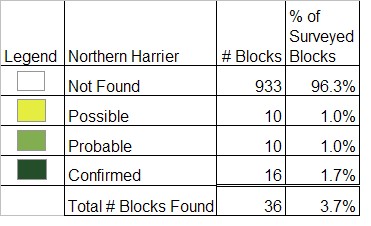Breeding Bird Atlases (BBA)
Find a Bird - BBA1
Breeding Bird Atlas 1 Species Accounts
Northern Harrier
Circus cyaneus
State Status
Threatened
Egg Dates
April 26 to June 25
Number of Broods
one

As with many open-country species, the Northern Harrier, commonly called the “Marsh Hawk,” has declined over much of its former range in Massachusetts. Cape Cod and the Islands harbor the state’s remaining nesting populations, although there still may be a few breeders in Hampden County. During the past century, development, reforestation, changing land uses, recreational impact, and other types of human disturbance have led to a decrease in the number of harriers in the Commonwealth. These birds are residents of open habitats, including cattail swamps, marshes, bogs, prairies, and agricultural land borders.
Nesting harriers begin arriving on their breeding grounds in late March in Massachusetts. Males are the first to return and establish territories in anticipation of the later arriving females. Northbound transients are observed during April.
Though Northern Harriers utilize territories of open dry grasslands, for the nest site they usually select areas within cattail swamps, marshes, or bogs, preferring wet areas for nesting. Nests are generally located near dense vegetation within the territory. Recent studies on Nantucket indicate that a stand of Highbush Blueberry is preferred. Harriers are sensitive to human disturbance during the early stages of nesting and may abandon a nest if they are bothered at this time.
Harriers are generally silent when they are not near the nest; however, during courtship displays and nest defense, they become quite vocal. During courtship, males, and often females as well, engage in sky-dancing displays, in which they fall from a height into a series of steep undulations. Aerial talon grappling is also a behavior related to territory defense.
The character of the site often determines the size of the nest. In wet areas, harriers may build nests of sticks, weeds, and grasses up to 3 feet across, but average nests are 13 to 20 inches across and 3 to 10 inches deep. Polygyny, the practice of one male mating with two or more females, has often been recorded in the Northern Harrier.
On Nantucket and Tuckernuck islands in 1986, eggs were recorded in nests from May 1 to June 20 and in 1987 from April 26 to June 25. The average clutch size in 1987 was four eggs (range three to five) (Tate, Melvin). A nest on Monomoy contained one egg on May 16 (Humphrey). There are records of up to nine eggs in a clutch, but five is the average number. Eggs are laid a day or more apart, and incubation may commence when the first egg is produced so that hatching is asynchronous. The incubation period ranges from 29 to 39 days. The young remain in the nest or its immediate vicinity until they fledge in approximately 35 to 37 days. Immatures are distinguished easily from the adult female by their fresh-looking plumages with pale feather edgings above and rufous underbody color.
The male supplies the female with food during incubation and the first week of brooding, and transfers can often be observed near the nest site. The female flies to the male and catches the prey that he drops. Both sexes join in nest defense and will attack and vocalize when a predator or human intruder approaches too closely.
The fall migration is protracted, with immatures departing as early as late August and some adult males passing through in early November. Peak migration occurs in early October. The wintering grounds extend from the northern states south through Mexico and the West Indies to northern South America. During winter in Massachusetts, Northern Harriers can be found generally along the coast and more uncommonly inland. The number of wintering birds has increased in recent years.
The Northern Harrier is listed as a threatened species in Massachusetts.
Map Legend and Data Summary
Atlas 1 data collected from 1975-1979


Note: locally uncommon on the Islands, uncommon on outer Cape Cod; rare elsewhere
Denver W. Holt



